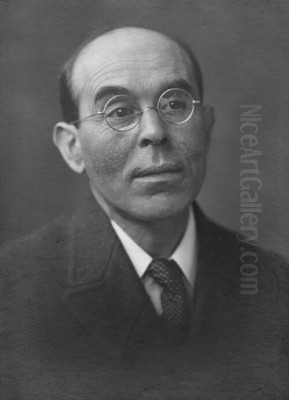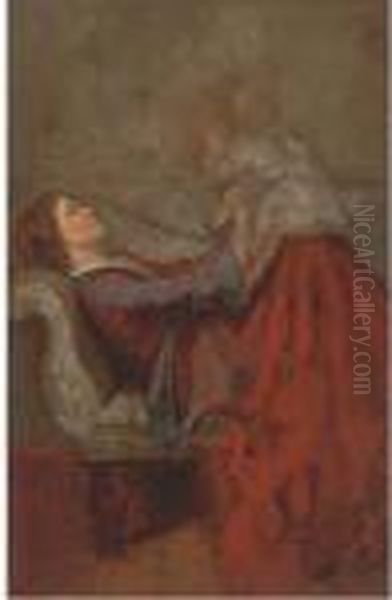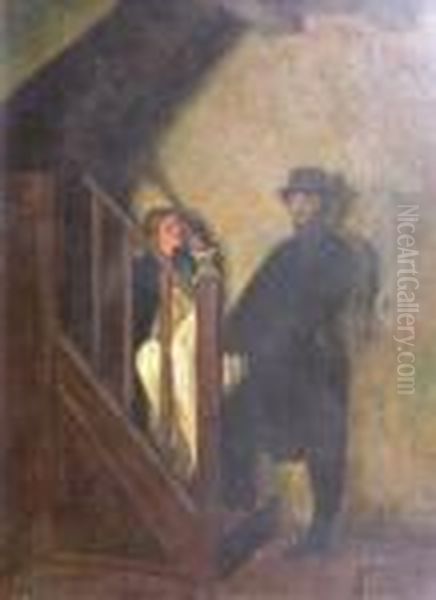
Sir William Rothenstein stands as a significant figure in British art history, a multifaceted talent whose career spanned the dynamic period from the late Victorian era through to the end of the Second World War. Born on January 29, 1872, and passing away on February 14, 1945, Rothenstein was not only a prolific artist but also an influential educator, writer, and connector of creative minds. His life and work offer a fascinating window into the artistic and intellectual currents of his time, marked by his engagement with various movements, his insightful portraiture, and his dedication to fostering art appreciation and education.
As a painter, printmaker, draughtsman, lecturer, and author, Rothenstein navigated the evolving landscape of modern art with keen observation and considerable skill. He emerged onto the art scene in the early 1890s and remained an active and respected presence until his death. His legacy is preserved not only in his diverse body of artwork but also in his extensive writings and the lasting impact he had on institutions like the Royal College of Art.
Early Life and Artistic Awakening in Bradford
William Rothenstein was born in Bradford, West Yorkshire, into a prosperous German-Jewish family. His father, Moritz Rothenstein, was a successful wool merchant who had emigrated from Germany in 1859. His mother was Bertha Dux. William was the fifth of six children, growing up in a household that, while commercially focused, allowed for the nurturing of his artistic inclinations. Bradford, a thriving industrial city during this period, provided the backdrop to his formative years.
His formal schooling took place at Bradford Grammar School. By his own account and that of others, his academic performance was generally unremarkable, with one notable exception: art. He displayed a clear and precocious talent for drawing, an aptitude that set his future path. Recognizing this potential, his family supported his decision to pursue art professionally.

At the young age of sixteen, Rothenstein left Bradford for London to further his artistic education. This move marked a significant step, taking him from the industrial north to the heart of the British art world. He enrolled at the prestigious Slade School of Fine Art, studying under Alphonse Legros, an artist known for his traditionalist yet rigorous approach. The Slade provided him with a solid foundation in drawing and painting techniques.
Parisian Immersion and the Avant-Garde
Following his time at the Slade, Rothenstein sought the vibrant, experimental atmosphere of Paris, the undisputed centre of the Western art world at the time. From 1889 to 1893, he continued his studies at the Académie Julian, a famous private art school known for attracting international students and fostering a less rigid environment than the official École des Beaux-Arts. This period was crucial for his development, exposing him to the latest artistic trends and influential figures.
In Paris, Rothenstein immersed himself in the city's bohemian and artistic circles. He formed connections with an astonishing array of leading artists and writers. He met and befriended James McNeill Whistler, whose sophisticated aesthetics and emphasis on tonal harmony left an impression. He also encountered the master Impressionist Edgar Degas, whose observational acuity and unconventional compositions were deeply admired.
His network expanded to include other key figures such as the Post-Impressionist painter Henri de Toulouse-Lautrec, known for his dynamic portrayals of Parisian nightlife, and the sculptor Auguste Rodin, whose expressive modelling was revolutionizing sculpture. These interactions provided Rothenstein with invaluable insights and inspiration, shaping his early artistic direction, which absorbed elements of Impressionism and French Naturalism. He developed a keen eye for character and a fluid, expressive line.
London, Portraiture, and The Yellow Book
Returning to England in 1893, Rothenstein settled initially in Oxford before moving to London. He quickly began to make a name for himself, particularly as a portraitist. His time in Paris had equipped him with a modern sensibility and a network of contacts that facilitated his entry into London's artistic and literary elite. He possessed a remarkable ability to capture not just a likeness but also the personality and presence of his sitters.
His early work included a series of lithographic portraits of notable Oxford figures. In London, he became associated with the circle around The Yellow Book, a leading avant-garde literary and art quarterly published between 1894 and 1897. Though perhaps less radical than its co-founder Aubrey Beardsley, Rothenstein contributed drawings and portraits to the publication, placing him firmly within the progressive artistic milieu of the 1890s.

During this period, he continued to cultivate important friendships. He met the writer and caricaturist Max Beerbohm in Oxford in 1893, initiating a lifelong, albeit sometimes complex, friendship. Beerbohm would later create numerous affectionate caricatures of Rothenstein. He also maintained connections with figures like Oscar Wilde, sharing dinners and conversations, as evidenced by anecdotes recorded in his memoirs. One such story involves a dinner with Wilde being interrupted by the boastful war artist Caton Woodville.
Master of the Portrait
Portraiture remained a cornerstone of William Rothenstein's artistic output throughout his career. He possessed a distinct talent for capturing the intellectual and creative figures of his time, leaving behind a valuable visual record of the era's luminaries. His approach often combined sensitive observation with a directness that avoided flattery, aiming instead for psychological depth and character.
He published several collections of his portrait drawings and lithographs, which were widely acclaimed. English Portraits (1898) featured prominent figures from various fields. Later came Twenty-Four Portraits (First Series, 1920) and Twenty-Four Portraits (Second Series, 1923), further cementing his reputation. His sitters included writers like Thomas Hardy (famously captured in an 1897 lithograph), H.G. Wells, Joseph Conrad, and W.B. Yeats, as well as artists and thinkers.
His painted portraits also demonstrate considerable skill. Works like Parting at Morning (1891) show his early engagement with narrative and mood, influenced by French painting. Mother and Child (c. 1903) reveals a tender intimacy, handled with delicate brushwork and tonal sensitivity. These works showcase his ability to handle oil paint effectively, complementing his mastery of drawing and lithography.
Exploring Diverse Themes: Landscapes and Jewish Life
While best known for his portraits, Rothenstein's artistic interests were broader. He produced landscapes, often depicting the English countryside, particularly around Gloucestershire where he later settled. Works like French Landscape reflect his earlier experiences abroad, while paintings such as The Butcher's Shop under the Trees demonstrate his ability to find artistic merit in everyday scenes, rendered with attention to light and atmosphere.
Rothenstein also explored themes related to his Jewish heritage. One of his most significant works in this vein is Jews Mourning in a Synagogue (1906), now housed in the Tate collection. This painting is a powerful and sombre depiction of religious observance, rendered with empathy and dignity. It reflects his engagement with Jewish life and traditions, a subject he returned to periodically, offering a personal perspective within the broader context of British art.
His versatility extended to different media. He was a skilled draughtsman, comfortable with pencil, chalk, and pastel. His drawings often served as studies for paintings or prints but also stand as accomplished works in their own right, valued for their immediacy and expressive line. This foundational skill in drawing underpinned all aspects of his artistic practice.
Innovations in Printmaking
Rothenstein made significant contributions to the art of printmaking, particularly lithography, during a period of revival for the medium in Britain. He embraced lithography early in his career, recognizing its potential for directness and tonal subtlety, qualities well-suited to portraiture. His 1897 portrait of Thomas Hardy is a prime example of his mastery in this medium.
He was not content merely to follow established techniques. Later in his career, particularly during the 1920s and beyond, he became increasingly experimental. He explored colour lithography and different approaches to woodcut and etching. His print Crimson Circle exemplifies this more abstract and experimental phase, showcasing his willingness to adapt and evolve his style.
His engagement with printmaking extended to collaboration. He worked with other artists and printers, sharing knowledge and techniques. His association with figures like Stanley William Hayter, a key figure in 20th-century printmaking (though their direct collaboration might be more nuanced than partnership), places him within the ongoing development of graphic arts. Rothenstein's advocacy and practice helped elevate the status of printmaking as a fine art form in Britain.
The Carfax Gallery and Promoting Modern Art
Beyond his own creative work, Rothenstein played an active role in the London art world through institutional involvement and promotion. In 1899, alongside the artist Charles Conder and others, he helped found the Carfax Gallery. Managed initially by John Fothergill, the gallery became an important venue for exhibiting modern art, including the work of Augustus John, Aubrey Beardsley, and Rothenstein himself.
The Carfax Gallery provided a platform for artists associated with the New English Art Club (NEAC), of which Rothenstein was also a member. The NEAC had been founded earlier as an alternative to the perceived conservatism of the Royal Academy, promoting styles influenced by French Impressionism and Realism. Rothenstein's involvement with both the NEAC and the Carfax Gallery highlights his commitment to supporting contemporary art and artists who were pushing boundaries.
These activities demonstrate Rothenstein's role not just as a creator but also as a facilitator and promoter within the art community. He understood the importance of exhibition spaces and supportive networks for the development and appreciation of new artistic directions. His efforts contributed to the gradual acceptance of modern art in Britain during the early 20th century.
An Enduring Interest in India
Rothenstein developed a deep and lasting interest in the art and culture of India, an engagement that significantly distinguished him among his British contemporaries. This interest was not merely aesthetic but also intellectual and organizational. In 1910, he was a key figure in the founding of the India Society in London.
The India Society aimed to promote the study and appreciation of Indian art, literature, and culture in Britain. At a time when colonial attitudes often marginalised or misunderstood Indian artistic traditions, the Society sought to foster greater understanding and respect. Rothenstein played an active role, advocating for Indian art and helping to organize exhibitions and lectures.
His interest may have been sparked or deepened by encounters with Indian intellectuals and artists, as well as by studying Indian art collections. While the provided texts don't detail specific travels to India, his commitment through the India Society was substantial. This engagement reflects a broader intellectual curiosity and a desire to look beyond the confines of European artistic traditions, contributing to a more global perspective on art history in Britain.
Service as a War Artist
William Rothenstein served as an official war artist during both the First and Second World Wars. This role involved documenting the war effort, personnel, and landscapes affected by conflict, creating a historical record through art. During World War I, he worked primarily on the Western Front, sketching soldiers, landscapes, and the machinery of war.
His work as a war artist often focused on portraiture, capturing the likenesses of military leaders and ordinary soldiers. These portraits carry the same observational acuity found in his civilian work, but imbued with the gravity of the wartime context. He depicted the human element of the conflict, often focusing on moments of quiet endurance or reflection rather than dramatic battle scenes.
During World War II, despite being in his late sixties and early seventies, he again contributed as a war artist, associated particularly with the Royal Air Force (RAF). His drawings and paintings from this period document airmen, airfields, and aircraft, contributing to the visual narrative of Britain's defence. This service underscores his commitment to contributing his artistic skills to the national effort during times of crisis.
Principal of the Royal College of Art
One of William Rothenstein's most significant contributions was his tenure as Principal of the Royal College of Art (RCA) in London, a position he held from 1920 to 1935. This was a period of considerable influence, during which he reshaped aspects of the college's curriculum and ethos, leaving a lasting mark on British art education.
He brought to the role his extensive experience as an artist, his wide network of contacts, and his belief in the importance of rigorous training combined with individual expression. He aimed to raise the standard of teaching and connect the college more closely with contemporary artistic practice. He emphasized drawing as a fundamental skill and encouraged students to develop their own distinct voices.
During his principalship, the RCA nurtured a generation of artists who would become prominent figures in British modernism, including sculptors Henry Moore and Barbara Hepworth, and painters like Edward Burra and Ceri Richards. While fostering innovation, Rothenstein also maintained a respect for tradition, seeking a balance between established skills and modern exploration. His leadership significantly enhanced the reputation and influence of the RCA.
Later Years, Writings, and Honours
In his later career, Rothenstein continued to paint, draw, and write prolifically. His dedication to the arts remained undimmed. In recognition of his significant contributions to British art and culture, he was knighted in 1931, becoming Sir William Rothenstein. This honour acknowledged his multifaceted career as an artist, educator, and advocate for the arts.
His writings form a crucial part of his legacy. His most famous work is his autobiography, Men and Memories, published in two volumes (1931-1932), covering his life and encounters from 1872 up to 1922. These memoirs provide invaluable firsthand accounts of the artistic and literary worlds of London and Paris during that period, filled with anecdotes about figures like Whistler, Degas, Wilde, Rodin, and many others. He also authored critical studies, including a book on Goya (1900) and A Plea for a Wider Use of Artists & Craftsmen (1916).
He remained connected to his roots, maintaining affection for his hometown of Bradford despite having left at sixteen. He wrote about the city's cultural influence on him in 1932 and visited periodically. His works continued to be exhibited, and retrospectives acknowledged his long and productive career. His art found homes in major public collections, including the Tate Gallery, the National Portrait Gallery, London, and university collections like those at Oxford.
Anecdotes and Personality
Rothenstein's memoirs and the accounts of others paint a picture of a man deeply embedded in the cultural life of his time, known for his sociability, intelligence, and sometimes sharp opinions. The anecdote involving Oscar Wilde and the boastful Caton Woodville offers a glimpse into the social dynamics and personalities within his circle. It highlights the wit and perhaps the occasional friction present in these gatherings of artistic egos.
His long friendship with Max Beerbohm, documented through correspondence and Beerbohm's numerous caricatures, reveals a relationship of mutual respect and affectionate teasing. Rothenstein appears in Beerbohm's drawings often as a figure of earnest intensity, sometimes slightly professorial, reflecting perhaps his serious dedication to art and education.
His enduring connection to Bradford, despite his cosmopolitan life in London and Paris, suggests a grounding in his origins. This connection manifested not only in personal visits but also in his willingness to reflect publicly on the city's impact on his development. This blend of local attachment and international experience characterized his unique position in British art.
Legacy and Conclusion
Sir William Rothenstein died on February 14, 1945, leaving behind a rich and complex legacy. He was a bridge figure, connecting the art worlds of late 19th-century Paris and early 20th-century London. His work absorbed influences from Impressionism and Naturalism but retained a distinctively British character, particularly in his insightful portraiture. He documented his era through the faces of its leading figures, creating an invaluable historical and artistic record.
His contributions extended far beyond his own canvases and printing plates. As Principal of the Royal College of Art, he shaped a generation of British artists. Through the Carfax Gallery and the India Society, he actively promoted modern and non-European art. His extensive writings, especially Men and Memories, offer unparalleled insights into the cultural life of his time.
While perhaps not as radical an innovator as some of his contemporaries like Picasso or Matisse, Rothenstein's strength lay in his versatility, his technical skill, his intellectual curiosity, and his profound engagement with the artistic community. He was a painter, printmaker, draughtsman, educator, writer, and cultural facilitator. His work is held in major collections worldwide, and his influence continues to be recognized. Sir William Rothenstein remains a pivotal figure, a 'portraitist of an era' whose life and work illuminate the vibrant and transformative period of British art he inhabited.